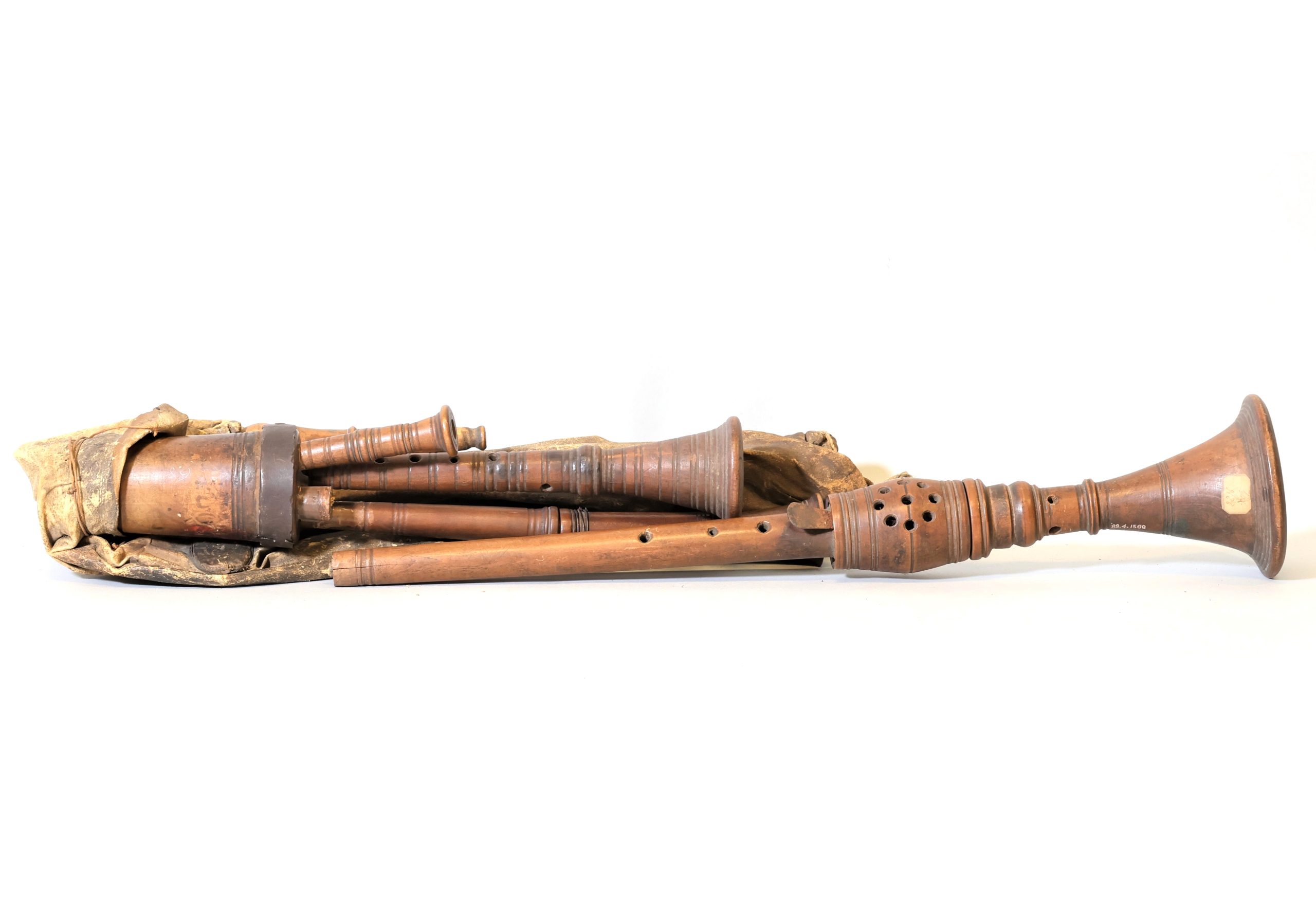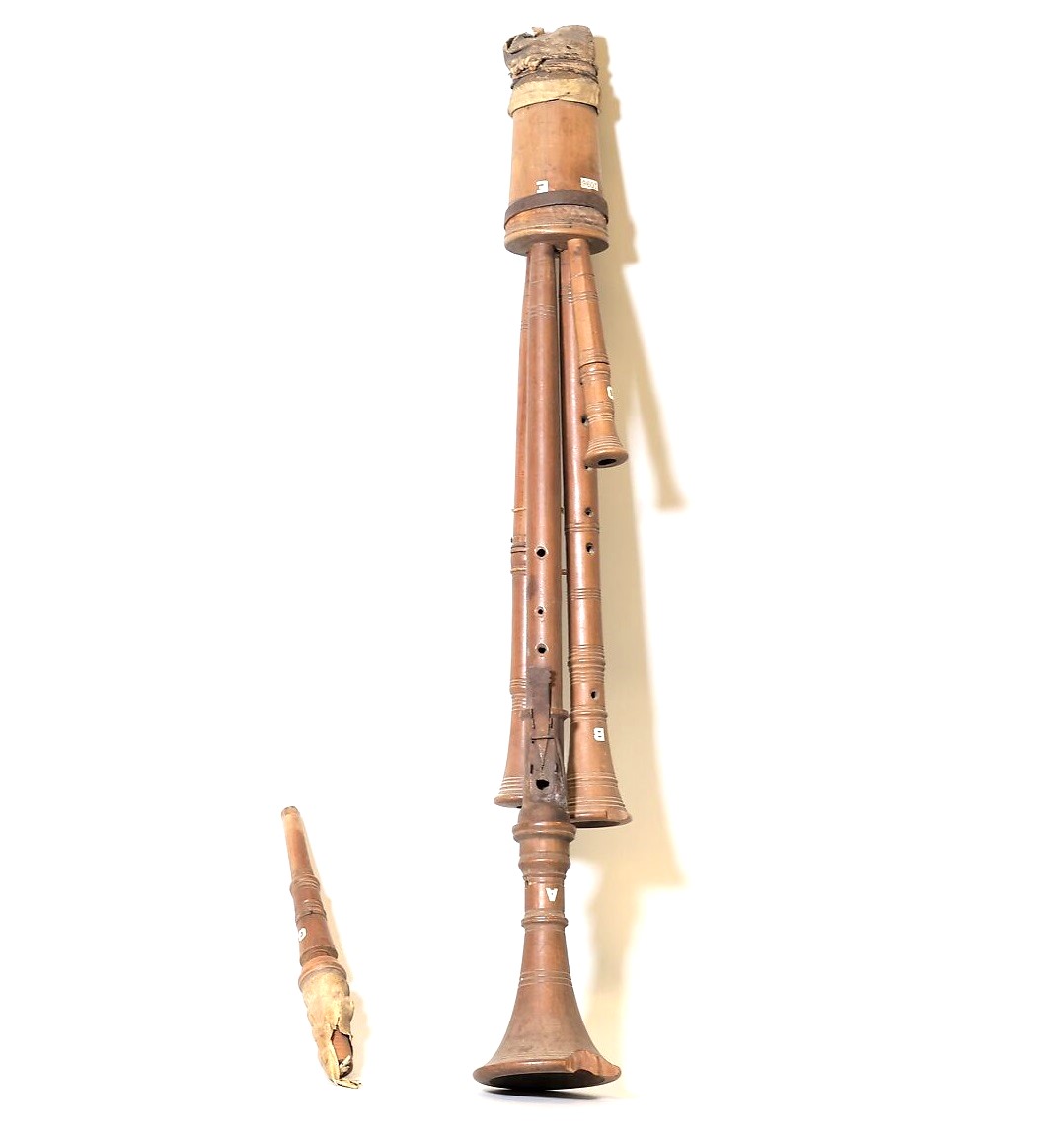Zampogna
Woodwinds
Europe
Ancient
Video
The Zampogna is an Italian bagpipe traditionally played in rural areas, particularly in southern Italy. It is a double-chantered instrument that has a rich, full-bodied sound, making it a distinctive part of folk music traditions. The name “Zampogna” is derived from the Latin word “Symphonia,” meaning harmony, which reflects its ability to produce multiple tones simultaneously. The instrument is known for its warm and resonant timbre, which is created by the simultaneous playing of drones and melody pipes. Typically played by shepherds and folk musicians, the Zampogna has been an essential element of Italian cultural and religious festivities, particularly during the Christmas season, when it is associated with traditional pastoral music.
Type of Instrument
The Zampogna falls under the category of aerophones, specifically bagpipes. It is a reed instrument that produces sound by the vibration of air passing through reeds within the chanters and drones. Unlike many other bagpipes, which have a single melody pipe, the Zampogna has two chanters, allowing for harmonized melodies. The instrument is inflated using a mouth-blown or bellows-blown air reservoir, ensuring a continuous supply of air to sustain the notes.
History
The Zampogna has its roots in Europe, particularly in the Mediterranean region, with strong ties to Italy. Its history dates back to ancient times, with its origins often traced to the Roman Empire, making it at least two millennia old. The earliest references to bagpipe-like instruments in Italy date to around the 1st century AD, with artistic depictions in Roman mosaics and sculptures suggesting that similar instruments were used by shepherds and common folk. The instrument continued to evolve throughout the Middle Ages and the Renaissance, eventually becoming a staple of Italian folk traditions.
Materials Used
The Zampogna is traditionally crafted using natural materials. The bag is made from animal hide, often from goats or sheep, which provides durability and flexibility. The chanters and drones are typically made from wood, such as olive, cherry, or boxwood, which contributes to the instrument’s warm tonal qualities. The reeds, essential for sound production, are usually made from cane or brass. Some modern versions incorporate synthetic materials for greater durability and consistency in performance.
Types of Zampogna
There are several types of Zampogna, each with regional variations in design and tuning. The most common types include:
Zampogna a Chiave: Features a key mechanism to allow for chromatic playing, offering more flexibility in musical expression.
Zampogna a Paro: A traditional form without keys, where both chanters play in parallel harmony, producing a more rustic sound.
Zampogna Molise: Popular in the Molise region, this type is known for its deep and resonant sound.
Zampogna Siciliana: Used in Sicilian folk music, it often has a more compact structure and a distinct tonal character.
Zampogna Calabrese: Characterized by its larger size and robust sound, often associated with ceremonial and festive occasions.
Characteristics
The Zampogna has several defining characteristics that distinguish it from other bagpipes:
Double-chantered design: Allows for harmony and counter-melody playing, making it unique among European bagpipes.
Variable drone configurations: Some versions have additional drone pipes to enrich the sound.
Regional tuning differences: Different areas in Italy have their own Zampogna tunings, leading to diverse soundscapes.
Rich, full sound: Capable of producing a broad spectrum of tones, from deep bass drones to bright melodic lines.
Handcrafted nature: Each Zampogna is traditionally handmade, resulting in slight variations that contribute to its individuality.
Sound Production
The Zampogna produces sound through the vibration of reeds in the chanters and drones. Air is blown into the bag, either through a mouthpiece or bellows, and pressure is applied to regulate airflow into the pipes. The double-chanter setup enables polyphonic playing, creating a layered and textured sound. The pitch is influenced by the length and material of the chanters and drones, while the reeds’ responsiveness affects the overall timbre and stability of the instrument.
Playing Methods
The Zampogna is played by squeezing the bag under the arm while fingering the holes on the chanters. Unlike many other bagpipes that use a separate blowpipe, the Zampogna’s air supply mechanism ensures continuous airflow, allowing for sustained notes. The musician controls dynamics and articulation by adjusting finger pressure and breath support. Ornamentation techniques, such as trills and grace notes, add expressiveness to the melodies.
Roles in Music
The Zampogna plays a significant role in various musical settings:
Folk music: Integral to traditional Italian folk ensembles, where it accompanies singing and dancing.
Religious ceremonies: Used during processions and festivals, especially in Catholic celebrations.
Christmas traditions: Frequently played in nativity scenes and pastoral music, symbolizing the shepherds’ presence at the birth of Christ.
Accompaniment for poetry and storytelling: Provides a musical backdrop for oral traditions and recitations.
Solo and ensemble performances: Can be played alone or alongside other folk instruments such as the tambourine, accordion, and violin.
Cultural Significance
The Zampogna holds deep cultural significance in Italian heritage. It is closely associated with rural traditions and the pastoral lifestyle of shepherds, who historically used the instrument to entertain themselves and their communities. Its connection to Christmas customs, particularly in regions like Abruzzo and Calabria, has made it a symbolic representation of Italian holiday festivities. In modern times, the Zampogna has experienced a resurgence through folk revivals, with musicians and artisans dedicated to preserving its legacy. Festivals and competitions celebrate its craftsmanship and musical tradition, ensuring that this ancient instrument continues to thrive in contemporary culture.
The Zampogna remains a treasured part of Italy’s musical identity, embodying centuries of history, artistry, and cultural expression. Its distinctive sound and unique construction make it an enduring symbol of Italian folk traditions, cherished by musicians and audiences alike.
FAQ
What is the history of the Zampogna?
The Zampogna is a traditional Italian bagpipe with roots in ancient times. It was played by shepherds in Southern Italy and dates back to Roman times. The instrument has evolved, but it remains a symbol of folk and religious traditions. It is commonly associated with Christmas music and rural heritage.
How is the Zampogna used?
The Zampogna is mainly used in Italian folk music, particularly during Christmas celebrations. It is played by itinerant musicians, often accompanied by the ciaramella, a reed pipe. The instrument is also performed at festivals and religious events, maintaining its deep cultural significance.
What are the features of the Zampogna?
The Zampogna consists of a leather bag, drone pipes, and melody pipes, each with double reeds. It comes in different regional variations, with distinct tunings and designs. Some versions have a single chanter, while others feature two melodic pipes, allowing for harmonized playing. The instrument is handcrafted from wood, traditionally using olive or cherry.
 Links
Links
References
Other Instrument
Categories



















